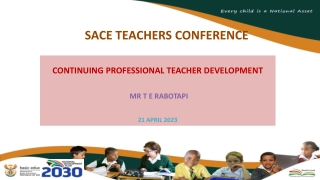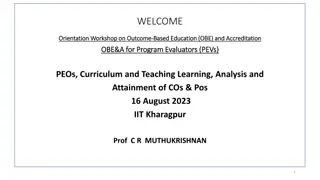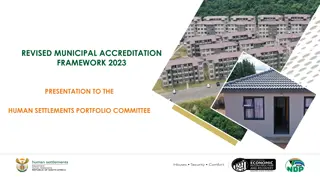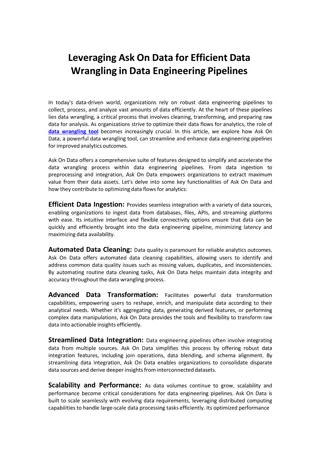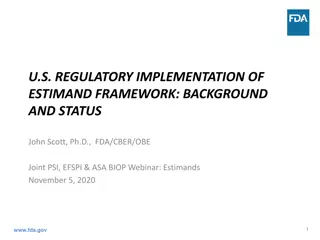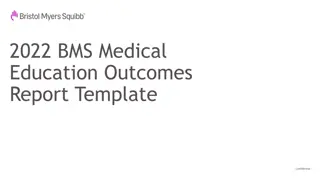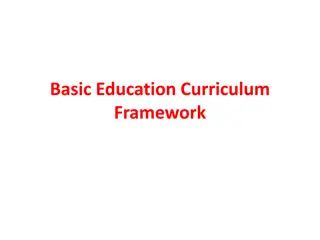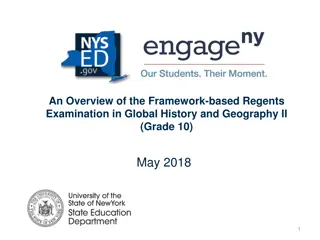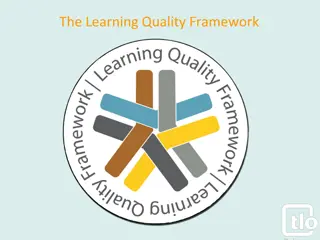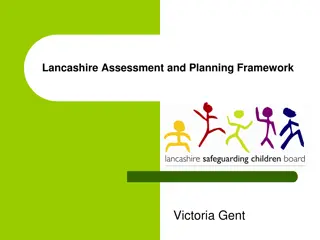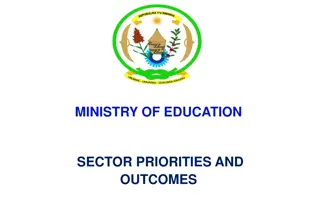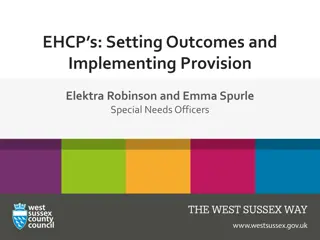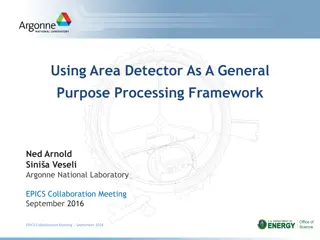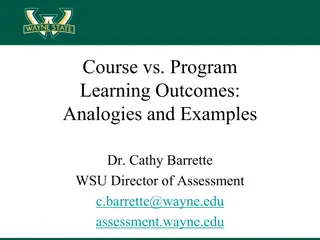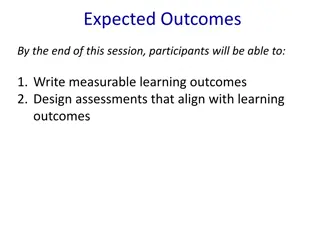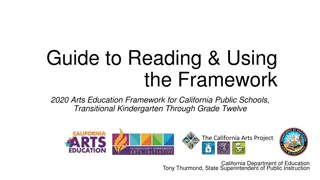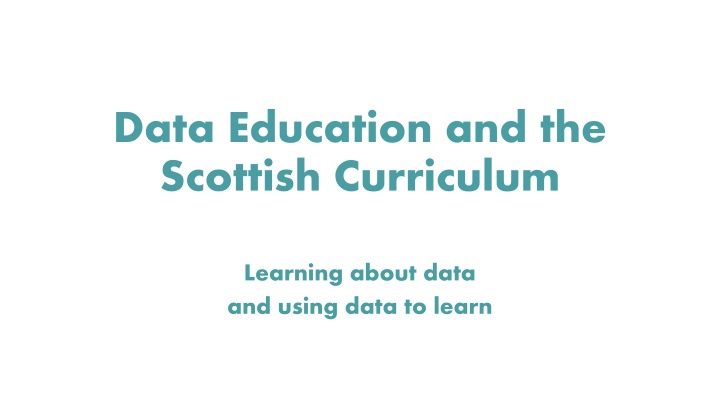
Learning About Data Skills in Scottish Curriculum
Explore the integration of data skills in the Scottish curriculum, including learning outcomes, frameworks, and applications in various subjects like Technologies, Mathematics, Literacy, and Social Studies. Discover how data education enhances students' abilities to search for information, analyze data, and communicate findings across different areas of study.
Download Presentation

Please find below an Image/Link to download the presentation.
The content on the website is provided AS IS for your information and personal use only. It may not be sold, licensed, or shared on other websites without obtaining consent from the author. If you encounter any issues during the download, it is possible that the publisher has removed the file from their server.
You are allowed to download the files provided on this website for personal or commercial use, subject to the condition that they are used lawfully. All files are the property of their respective owners.
The content on the website is provided AS IS for your information and personal use only. It may not be sold, licensed, or shared on other websites without obtaining consent from the author.
E N D
Presentation Transcript
Data Education and the Scottish Curriculum Learning about data and using data to learn
Data Education Framework Outcomes to learn Data Skills Context to apply Data Skills Outcomes across the whole Broad General Education grouped into topics suitable for applying Data Skills Outcomes in Technologies, Mathematics, Literacy and Social Subjects suitable for learning core data concepts.
Learning Data Skills Outcomes for learning core data concepts, such as: Technologies: Searching for information, understanding and using information, representing ideas and concepts Numeracy and Maths: identifying patterns, chance and uncertainty, data and analysis Literacy: Communicating findings and explaining data analysis to others Social Studies: Using current and historical evidence
Applying data skills Outcomes across the whole Broad General Education grouped into topics suitable for applying Data Skills Science, Technologies, Numeracy and Mathematics, Social Studies, Expressive Arts, Personal and Social Education, Literacy, Modern Languages
Diet and Fitness Diet and fitness tracking, choosing and increasing physical activity, tracking sleep and nutrition E 1 2 3 4
Level Area Topic Code Curriculum statement Benchmarks Health and Wellbeing Activity, Diet, Rest and Sleep Early HWB 0-27a I know that being active is a healthy way to be. Demonstrates different ways of being active, for example, energetic play. I can describe how I feel after taking part in energetic activities and I am becoming aware of some of the changes that take place in my body. I am aware of the role physical activity plays in keeping me healthy and know that I also need to sleep and rest to look after my body. Health and Wellbeing Activity, Diet, Rest and Sleep Identifies how being active affects their body, for example, raised heartbeat, getting hot. Gives reasons why being active is good for health Early HWB 0-28a Suggests different ways of being active and the positive effect this can have on health. Articulates how much sleep is needed in childhood and why this is important. Health and Wellbeing Activity, Diet, Rest and Sleep Level 1 HWB 1-27a I understand that my body needs energy to function and that this comes from the food that I eat. I am exploring how physical activity contributes to my health and wellbeing Health and Wellbeing Activity, Diet, Rest and Sleep Level 1 HWB 1-28a Explains that food is the fuel that gives the body energy. I can explain why I need to be active on a daily basis to maintain good health and try to achieve a good balance of sleep, rest and physical activity. Health and Wellbeing Activity, Diet, Rest and Sleep Explains the interrelationship of daily physical activity, diet, rest and sleep on health and wellbeing. Level 2 HWB 2-27a Identifies a range of activities at different intensities and explains how these may influence food / energy requirements, for example, 100m sprint higher energy requirement; recreational bike ride lower energy requirement. Health and Wellbeing Activity, Diet, Rest and Sleep I can explain the links between the energy I use while being physically active, the food I eat, and my health and wellbeing. Level 2 HWB 2-28a I can explain why I need to be active on a daily basis to maintain good health and try to achieve a good balance of sleep, rest and physical activity. Health and Wellbeing Activity, Diet, Rest and Sleep Evaluates own lifestyle in respect of daily physical activity, diet, rest and sleep and impact on health and wellbeing. Level 3 HWB 3-27a Health and Wellbeing Activity, Diet, Rest and Sleep I can explain the links between the energy I use while being physically active, the food I eat, and my health and wellbeing. Explains the impact of an energy imbalance on health and wellbeing, for example, becoming overweight, lethargy. Level 3 HWB 3-28a Uses a variety of instruments to monitor and record aspects of health, for example, pulse rate, blood pressure and recovery rate and gives examples of other aspects of health that may be monitored, for example, cholesterol and BMI. Researches one condition that is screened for (for example, bowel cancer, macular degeneration and diabetes) and describes the symptoms of the condition. I have explored the role of technology in monitoring health and improving the quality of life. Level 3 Science Biological Systems SCN 3-12b I have investigated factors which can influence participation in physical activity and food choices, and the impact of activity on population health in the Scottish and wider contexts. I can use this information to discuss policies and inform my own health choices. Explains factors which influence participation in physical activity and food choices, for example, socio-economic, media, peer pressure. Analyses current national guidance and policy and explains their impact on own health choices, for example, sugar intake, physical activity targets. Health and Wellbeing Activity, Diet, Rest and Sleep Level 4 HWB 4-28a
Nutrition and the Journey of Food Nutrition, choosing healthy foods food packaging and the role of media and advertising Agriculture and food production, choosing local products The journey of food, and calculating food miles E 1 2 3 4
Level Area Topic Code Curriculum statement Benchmarks Health and Wellbeing Food and Health: The Journey of Food HWB 0-35aI explore and discover where foods come from as I choose, prepare and taste different foods. Describes which foods come from plants and which come from animals when working with and tasting foods. Early When preparing and cooking a variety of foods, I am becoming aware of the journeys which foods make from source to consumer, their seasonality, their local availability and their sustainability. Identifies how to prevent food related waste, for example, composting peelings, reusing leftovers, reducing use of packaging. Maps sources of food and drink in the local area. Health and Wellbeing Food and Health: The Journey of Food Level 1 HWB 1-35a Health and Wellbeing Food and Health: The Journey of Food HWB 1-37aI am discovering the different ways that advertising and the media can affect my choices. Level 1 Describes at least three ways that advertising and media can affect our food choices. Describes the journey of food from source to plate for example, from the sea, farms or factories to markets, supermarkets or direct to consumer. Creates a dish using fresh, local, seasonal ingredients and calculates food miles of key ingredients. Explains the benefits of waste management, for example, the 3 Rs - reduce, reuse, recycle. When preparing and cooking a variety of foods, I am becoming aware of the journeys which foods make from source to consumer, their seasonality, their local availability and their sustainability. Health and Wellbeing Food and Health: The Journey of Food Level 2 HWB 2.35a Health and Wellbeing Food and Health: The Journey of Food HWB 2-36aBy investigating food labelling systems I can begin to understand how to use them to make healthy food choices. Uses different food labelling systems to select foods for a specified dietary requirement, for example, low in fat. Level 2 Health and Wellbeing Food and Health: The Journey of Food I can understand how advertising and the media are used to influence consumers. Identifies three methods of persuasion used by media / advertisers to influence consumers, for example, logos. Level 2 HWB 2-37a Health and Wellbeing Food and Health: The Journey of Food HWB 3-34aHaving explored a range of issues which may affect food choice, I can discuss how this could impact on the individual s health. Explains factors that could influence choice of food, for example, media, poverty, peer pressure, seasonality, sustainability, environmental / ethical issues and potential impact on health. Level 3 Using my knowledge of nutrition and current healthy eating advice, I can evaluate the information on food packaging, enabling me to make informed choices when preparing and cooking healthy dishes. Health and Wellbeing Food and Health: The Journey of Food Evaluates information on food packaging and uses it to make informed choices when selecting food for given situations. Level 3 HWB 3-36a Having evaluated the role of agriculture in the production of food and raw material, I can draw reasoned conclusions about the environmental impacts and sustainability. Evaluates the role of agriculture in food production and draws at least three reasoned conclusions about the environmental impacts and therefore the sustainability of these methods. People, Place and Environment Level 4 Social Studies SOC 4-09a Health and Wellbeing Food and Health: The Journey of Food HWB 4-34aHaving explored a range of issues which may affect food choice, I can discuss how this could impact on the individual s health. Identifies and explains different influences on consumer choice, for example, the environment, social justice, food security Level 4 Health and Wellbeing Food and Health: The Journey of Food HWB 4-37aBy investigating the different influences on the consumer, I can discuss how the consumer can be influenced by external sources. Level 4 Having investigated the effects of food processing on the nutritional value of foods, I can critically assess the place of processed foods in a healthy balanced diet. Health and Wellbeing Food and Health: The Journey of Food Evaluates the role of processed foods for consumers, for example, cost, shelf life, availability, nutritional value. Level 4 HWB 4-35a
Science: Chemical Changes Water and air pollution, such as measuring air quality near school and roads or measuring pH levels or fish tank or aquaponics system, water conservation E 1 2 3 4
Level Area Topic Code Curriculum statement Benchmarks Uses knowledge of the water cycle to explain how the quantity of water on the Earth has remained approximately the same. Investigates and discusses the methods used to purify water, for example, sedimentation, filtration, evaporation, desalination and the addition of chemicals such as chlorine. Researches methods used to conserve water within the home, school and globally and communicates findings to others. Discusses the many uses of water, for example, to support all living things, in preservation (ice) and to generate electricity. Knows that indicators, such as universal indicator, are chemicals which produce different colours when placed in acid and alkali/bases. Investigates and describes the colour changes of indicators when added to acid/bases. Investigates and describes the pH of some everyday substances. Identifies substances as acidic (pH of less than 7), alkaline/basic (pH greater than 7) or neutral (equal to 7). Investigates and describes what happens to the pH when an acid is added to an alkali/basic. Analyses and interprets findings from environmental sample data to identify the quantities of pollutants present. Gives at least one reason for the presence of a pollutant in an environmental sample and describes the environmental change which may occur as a result of the presence of the pollutant. I have investigated different water samples from the environment and explored methods that can be used to clean and conserve water and I am aware of the properties and uses of water. Level 2 Science Chemical changes SCN 2-18a Having taken part in practical activities to compare the properties of acids and bases, I have demonstrated ways of measuring and adjusting pH and can describe the significance of pH in everyday life. Level 3 Science Chemical changes SCN 3-18a I can monitor the environment by collecting and analysing samples. I can interpret the results to inform others about levels of pollution and express a considered opinion on how science can help to protect our environment. Level 4 Science Chemical changes SCN 4-18a
Science: Plants and Biodiversity Biodiversity, using sensors to monitor a growing environment, plant and food production, such as hydroponics farming project E 1 2 3 4
Level Area Topic Code Curriculum statement Benchmarks I can help to design experiments to find out what plants need in order to grow and develop. I can observe and record my findings and from what I have learned I can grow healthy plants in school. I have collaborated in the design of an investigation into the effects of fertilisers on the growth of plants. I can express an informed view of the risks and benefits of their use. Observes, collects and measures the outcomes from growing plants in different conditions, for example, by varying levels of light, water, air, soil/nutrients and heat. Structures a presentation or report, with support, to present findings on how plants grow. Biodiversity and Interdependence Level 1 Science SCN 1-03a Collaborates with others to present a reasoned argument, based on evidence, of the risks and benefits of using fertilisers, demonstrating understanding of the underlying scientific concepts. Biodiversity and Interdependence Level 2 Science SCN 2-03a Applies knowledge gained from practical investigations to explain how green plants make their own food in the form of sugars and store this as starch. Investigates and presents information on how plants help to sustain life, for example, by providing oxygen, food, habitat, raw materials and medicines. Interprets data and information to establish a link between the use of fertilisers and plant yield and nutrient levels in the soil. Researches an agricultural method, for example, chemical fertilisers, herbicides, pesticides, organic methods, genetic modification (GM) and biological control and evaluates their impact on food production. I have collaborated on investigations into the process of photosynthesis and I can demonstrate my understanding of why plants are vital to sustaining life on Earth. Biodiversity and Interdependence Level 3 Science SCN 3-02a Through investigations and based on experimental evidence, I can explain the use of different types of chemicals in agriculture and their alternatives and can evaluate their potential impact on the world s food production. I have propagated and grown plants using a variety of different methods. I can compare these methods and develop my understanding of their commercial use. I can contribute to the design of an investigation to show the effects of different factors on the rate of aerobic respiration and explain my findings. Through investigating the nitrogen cycle and evaluating results from practical experiments, I can suggest a design for a fertiliser, taking account of its environmental impact. Biodiversity and Interdependence Level 3 Science SCN 3-03a Compares natural and artificial techniques to propagate plants, for example, seeds, bulbs and cuttings, and suggests commercial uses such as food production and food security. Biodiversity and Interdependence Level 4 Science SCN 4-02a Explains, using experimental findings, the effect of different factors on the rate of aerobic respiration. Uses the word equation to describe the process of aerobic respiration. Biodiversity and Interdependence Level 4 Science SCN 4-02b Describes the nitrogen cycle and explains the importance of each stage. Explores and explains the possible impact of the use of fertilisers, for example, algal blooms. Biodiversity and Interdependence Level 4 Science SCN 4-03a
Weather and Climate Record and measure weather Comparing weather with other countries Impact of weather and climate on living things Impact of climate change on a region E 1 2 3 4
Level Area Topic Code Curriculum statement Benchmarks While learning outdoors in differing weathers, I have described and recorded the weather, its effects and how it makes me feel and can relate my recordings to the seasons. By using a range of instruments, I can measure and record the weather and can discuss how weather affects my life. By comparing my local area with a contrasting area outwith Britain, I can investigate the main features of weather and climate, discussing the impact on living things. Names and talks about at least two different kinds of weather. Draws pictures to record the weather for three days. Describes how weather affects the activities they can undertake. Talks about how they feel about different kinds of weather. People, Place and Environment Early Social Studies SOC 0-12a People, Place and Environment Uses instruments to measure and record at least two different weather elements, for example, temperature, rainfall, wind direction. Level 1 Social Studies SOC 1-12a Compares and contrasts the differing effects of the weather on the people and society of Britain and a contrasting area, providing at least three similarities and/or differences. People, Place and Environment Level 2 Social Studies SOC 2-12a Demonstrates a basic understanding of the relationship between weather and climate. Provides a simple explanation for a weather pattern within a selected climate zone, for example, convection rainfall in the rainforest. I can investigate the relationship between climate and weather to be able to understand the causes of weather patterns within a selected climate zone. People, Place and Environment Level 3 Social Studies SOC 3-12a I can carry out a geographical enquiry to assess the impact and possible outcomes of climate change on a selected region and can propose strategies to slow or reverse the impact. People, Place and Environment Suggests the impact and possible outcomes of climate change on a chosen region and proposes reasoned strategies to slow or reverse the impact. Level 4 Social Studies SOC 4-12b
Climate, environment and sustainability Looking after the environment Consequences of an environmental issue Sustainability of resources Climate and burning fuels E 1 2 3 4
Level Area Topic Code Curriculum statement Benchmarks I explore and appreciate the wonder of nature within different environments and have played a part in caring for the environment. I can consider ways of looking after my school or community and can encourage others to care for their environment. I can discuss the environmental impact of human activity and suggest ways in which we can live in a more environmentally-responsible way. Identifies different methods of taking journeys. Expresses thoughts about which ways of travelling impact the environment both positively and negatively. People, Place and Environment Early Social Studies SOC 0-08a People, Place and Environment Level 1 Social Studies SOC 1-08a Identifies a way in which the school looks after its environment. Identifies at least three impacts of human activity on the environment. Suggests at least three ways in which people can live in a more environmentally responsible way. Explains how the levels of carbon dioxide in the atmosphere have increased over time, for example, through respiration of organisms, deforestation and increased combustion of fuels. Draws on supporting evidence, quotes and sources to demonstrate an association between carbon dioxide in the atmosphere and increasing global temperatures as a result of the greenhouse effect. People, Place and Environment Level 2 Social Studies SOC 2-08a I can explain some of the processes which contribute to climate change and discuss the possible impact of atmospheric change on the survival of living things. Processes of the Planet Level 3 Science SCN 3-05b I can identify the possible consequences of an environmental issue and make informed suggestions about ways to manage the impact. People, Place and Environment Provides a simple explanation of at least three consequences of an environmental issue, and for each suggest how they could be managed. Level 3 Social Studies SOC 3-08a Describes the steps in the carbon cycle and explains how processes such as respiration, photosynthesis and burning carbon-based fuels affect the balance of gases in the air. Researches the effects of changes in the balance of gases in the air and shares their scientific findings in an appropriate manner. Through exploring the carbon cycle, I can describe the processes involved in maintaining the balance of gases in the air, considering causes and implications of changes in the balance. Processes of the Planet Level 4 Science SCN 4-05b I can discuss the sustainability of key natural resources and analyse the possible implications for human activity. People, Place and Environment Evaluates the sustainability of at least two key natural resources and analyses possible implications for human activity. Level 4 Social Studies SOC 4-08a
Energy use and impact of technologies Societal implications of Technologies Energy use, carbon footprint of products Energy sources and sustainability, for example measuring and logging energy use, using smart meters and understanding the data E 1 2 3 4
Level Area Topic Code Curriculum statement Benchmarks Identifies and talks about types of energy that we get from different energy sources, for example, light, sound, heat and electrical. Uses knowledge of different energy sources, for example, sun, food, fuel, wind and waves, to discuss the importance of different types of energy for everyday life and survival. I am aware of different types of energy around me and can show their importance to everyday life and my survival. Energy sources and sustainability Level 1 Science SCN 1-04a I can take appropriate action to ensure conservation of materials and resources, considering the impact of my actions on the environment. I understand how technologies help provide for our needs and wants, and how they can affect the environment in which we live. Technologies: societal implications Identifies ways in which energy can be saved. Understands how and where we waste materials and resources. Level 1 Technologies TCH 1-06a Technologies: societal implications Demonstrates an understanding of how technologies, by meeting our needs and wants, affect the environment in which we live. Level 1 Technologies TCH 1-07a Demonstrates understanding of the law of conservation of energy (energy can be converted from one form to another but cannot be created or destroyed). Identifies the common types of energy (kinetic, potential, electrical, chemical, light, sound and heat) used in energy transfers and transformations that occur in everyday appliances. Explains that when energy transfers and transformations take place, energy is converted into useful and wasted energy, for example a mechanical braking system transforms kinetic energy into heat energy which is dissipated to the atmosphere as waste heat. Researches non-renewable sources of energy, such as fossil fuels and nuclear, and discusses how these are used in Scotland. Draws on increasing knowledge and understanding to suggest ways in which they can reduce their own energy use and live more sustainably. By considering examples where energy is conserved, I can identify the energy source, how it is transferred and ways of reducing wasted energy. Energy sources and sustainability Level 2 Science SCN 2-04a Through exploring non-renewable energy sources, I can describe how they are used in Scotland today and express an informed view on the implications for their future use. I can analyse how lifestyles can impact on the environment and Earth s resources and can make suggestions about how to live in a more sustainable way. I can make suggestions as to how individuals and organisations may use technologies to support sustainability and reduce the impact on our environment. Energy sources and sustainability Level 2 Science SCN 2-04b Technologies: societal implications Level 2 Technologies TCH 2-06a Explains how and why it is important to conserve energy. Technologies: societal implications Discusses the advantages and disadvantages of how technologies impact on the environment for example, renewable energy technologies. Level 2 Technologies TCH 2-07a
Level Area Topic Code Curriculum statement Benchmarks Applies knowledge from practical investigations to explain how heat is transferred by conduction, convection and radiation. Establishes a link between heat loss in buildings and the temperature difference between the inside and outside of the building. Applies understanding of thermal energy efficiency, conductors and insulators to explain how materials can be used in building design to reduce heat loss, for example, in double and triple glazing. Presents research findings on the advantages and disadvantages associated with the use of renewable energy sources and their impact on society, demonstrating an informed view based on evidence. I can use my knowledge of the different ways in which heat is transferred between hot and cold objects and the thermal conductivity of materials to improve energy efficiency in buildings or other systems. Energy sources and sustainability Level 3 Science SCN 3-04a By investigating renewable energy sources and taking part in practical activities to harness them, I can discuss their benefits and potential problems. By contributing to an investigation on different ways of meeting society s energy needs, I can express an informed view on the risks and benefits of different energy sources, including those produced from plants. Energy sources and sustainability Level 3 Science SCN 3-04b Applies knowledge and understanding from different areas of the curriculum to express an informed view of the risks and benefits of different energy sources, including at least one energy source derived from plants. Energy sources and sustainability Level 4 Science SCN 4-04a Through investigation, I can explain the formation and use of fossil fuels and contribute to discussions on the responsible use and conservation of finite resources. Discusses, following research, the formation and use of fossil fuels and the need to use remaining fossil fuel resources responsibly, for example, to preserve finite supplies, limit pollution and reduce emissions of greenhouse gases. Energy sources and sustainability Level 4 Science SCN 4-04b I can examine a range of materials, processes or designs in my local community to consider their environmental, social and economic impact. I can present conclusions about the impact of technologies on the economy, politics and the environment. Technologies: societal implications Demonstrates an understanding of the impact of materials and processes on design. Level 4 Technologies TCH 4-06a Technologies: societal implications Explains the impact of technologies on globalisation, patterns of work and conditions of employment. Level 4 Technologies TCH 4-07a
Maps and Landscape features Understanding landscape features, identifying these on maps Creating maps of the local area Using GIS systems to gather and interpret data E 1 2 3 4
Level Area Topic Code Curriculum statement Benchmarks I explore and discover the interesting features of my local environment to develop an awareness of the world around me. I can describe and recreate the characteristics of my local environment by exploring the features of the landscape. Having explored the landscape of my local area, I can describe the various ways in which the land has been used. Through activities in my local area, I have developed my mental map and sense of place. I can create and use maps of the area. To extend my mental map and sense of place, I can interpret information from different types of maps and am beginning to locate key features within Scotland, UK, Europe or the wider world. People, Place and Environment Identifies simple features of the local environment, for example, hill, river, road, railway. Early Social Studies SOC 0-07a People, Place and Environment Draws or makes a model of features in their local landscape, for example, hill, river, building. Level 1 Social Studies SOC 1-07a People, Place and Environment Describes at least three different ways in which land is used in the local area, for example shops, houses, farming. Level 1 Social Studies SOC 1-13a People, Place and Environment Level 1 Social Studies SOC 1-14a Produces a basic map for a familiar journey. Extracts information from more than one kind of map. Locates continent names, country names, capital cities, rivers and railways on maps of Scotland, the UK, Europe and areas further afield. People, Place and Environment Level 2 Social Studies SOC 2-14a Reviews at least two simple graphical sources to interpret information and form a conclusion, for example, a map and a graph. Uses relevant numeracy and digital technology skills to interpret at least two sources of data from maps and graphical information systems. Locates increasingly complex features such as different physical landscape features and human features on maps of Scotland, the UK, Europe and the wider world for example, hills, mountains, valleys, population. I can use a range of maps and geographical information systems to gather, interpret and present conclusions and can locate a range of features within Scotland, UK, Europe and the wider world. People, Place and Environment Level 3 Social Studies SOC 3-14a I can use specialised maps and geographical information systems to identify patterns of human activity and physical processes. People, Place and Environment Evaluates different types of maps, and geographical representations of information to inform discussion on at least three topics. Level 4 Social Studies SOC 4-14a
Journeys and travel Comparing different methods of transport Impacts to the environment from journeys Mapping and modelling journeys Impact of developments on transport infrastructure E 1 2 3 4
Level Area Topic Code Curriculum statement Benchmarks I explore and appreciate the wonder of nature within different environments and have played a part in caring for the environment. I have experimented with imaginative ways such as modelling and drawing, to represent the world around me, the journeys I make and the different ways I can travel. Identifies different methods of taking journeys. Expresses thoughts about which ways of travelling impact the environment both positively and negatively. Draws or produces simple models of aspects of the local area, for example roads or buildings. Draws a simple map, or shares a relevant experience of the route of a straightforward journey, and the method of transport which was used. Identifies at least four ways in which journeys can be made. Describes at least one advantage and disadvantage for each form of transport. Shares knowledge about the impact of the various types of transport on the environment either verbally or in writing. People, Place and Environment Early Social Studies SOC 0-08a People, Place and Environment Level 1 Social Studies SOC 0-09a Having explored the ways journeys can be made, I can consider the advantages and disadvantages of different forms of transport, discussing their impact on the environment. People, Place and Environment Level 2 Social Studies SOC 2-09a I can assess the impact of developments in transport infrastructure in a selected area and can contribute to a discussion on the development of sustainable systems. Assesses the impact of developments in transport infrastructure in a chosen area. Contributes to a discussion on the development of sustainable systems. People, Place and Environment Level 4 Social Studies SOC 4-09b
Trade and Ethical issues in Society Society and Business, ethical issues in trade Finding out where goods come from Using Gapminder to compare Scotland to other countries, investigate cultural, social and economic differences Ethical issues of technological developments E 1 2 3 4
Level Area Topic Code Curriculum statement Benchmarks Compares and contrasts the lifestyle and culture of the citizens of Scotland as compared to the citizens of another country. Describes the basic needs of human beings. Draws valid conclusions as to why some countries can meet these needs better than others. By comparing the lifestyle and culture of citizens in another country with those of Scotland, I can discuss the similarities and differences. People in Society, Economy and BusinessSOC 2-19a Level 2 Social Studies Through exploring ethical trading, I can understand how people s basic needs are the same around the world, discussing why some societies are more able to meet these needs than others. I can evaluate the implications for individuals and societies of the ethical issues arising from technological developments. People in Society, Economy and BusinessSOC 2-20a Describes and pros and cons of using Fairtrade products and community service providers such as credit unions. Level 2 Social Studies Technologies: societal implications Level 3 Technologies TCH 3-06a Demonstrate an awareness of ethical issues around product development Identifies at least three social and economic differences between developed and developing countries, for example infant mortality rate, % adult literacy rate, Gross National Product per capita. Suggests possible ways these differences would be reduced, and provide valid opinions as to their likely success. Identifies at least two ethical issues related to business practices, for example, Fairtrade, Credit Unions, food banks, zero hours contracts, recycling and packaging. Describes how different businesses and not for profit organisations help to satisfy needs and wants. I can compare the social and economic differences between more and less economically-developed countries and can discuss the possibilities for reducing these differences. People, Place and Environment Level 3 Social Studies SOC 3-11a When participating in an enterprise activity, I can explore ethical issues relating to business practice and gain an understanding of how businesses help to satisfy needs. People in Society, Economy and BusinessSOC 3-20a Level 3 Social Studies I can present conclusions about the impact of the globalisation of trade on patterns of work and conditions of employment in Scotland, the UK or beyond. I can critically examine how some economic factors can influence individuals, businesses or communities. People in Society, Economy and BusinessSOC 3-20b Identifies the advantages and disadvantages of international trade, and issues around free trade agreements. Level 3 Social Studies People in Society, Economy and BusinessSOC 4-20a Critically examines how at least three economic factors can influence the decisions and behaviours of individuals, businesses or communities. Level 4 Social Studies
Ethics and debates with Controversial science Debate moral and ethics issues with controversial biological procedures, such as stem cells or DNA profiling Ethical implications of collecting genetic information E 1 2 3 4
Level Area Topic Code Curriculum statement Benchmarks Knows that DNA is found in the nucleus of most cells and that it contains the instructions for the development and function of living things (genetic code). Describes a gene as a piece of DNA which controls specific characteristics in an individual and demonstrates understanding that every individual has a unique combination of genes. Describes DNA profiling as a way of using technology to analyse DNA to see a unique pattern for an individual and gives examples of practical applications (paternity tests and forensics). Presents reasoned arguments on the ethical implications of collection, processing, storage and ownership of genetic information or DNA profiles. Formulates a reasoned argument, based on evidence and using correct scientific vocabulary, to debate moral and ethical issues of the chosen controversial biological procedure, for example, the collection and use of stem cells and DNA profiling. I have extracted DNA and understand its function. I can express an informed view of the risks and benefits of DNA profiling. Level 3 Science Inheritence SCN 3-14b Body systems and cells SCN 4-13cI can debate the moral and ethical issues associated with some controversial biological procedures. Level 4 Science
Society and Community Society and Business - community roles, needs and requirements For example Data Town activities and scoping IoT projects to meet community needs E 1 2 3 4
Level Area Topic Code Curriculum statement Benchmarks By exploring my local community, I have discovered the different roles people play and how they can help. In real-life and imaginary play, I explore how local shops and services provide us with what we need in our daily lives. By exploring my community and the groups within it, I can identify and consider different types of housing and how they meet needs. I can contribute to a discussion of the difference between my needs and wants of those of others around me. I have developed an understanding of the importance of local organisations in providing for the needs of my community. Having explored my local area, I can present information on different places to live, work and relax and interesting places to visit. People in Society, Economy and BusinessSOC 0-16a Early Social Studies Identifies at least two people who provide help in the community. People in Society, Economy and BusinessSOC 0-20a Identifies at least two different types of shops or services families might use, for example, supermarket or health centre. Early Social Studies People, Place and Environment Identifies at least two different types of housing and the kinds of households who may inhabit them. Level 1 Social Studies SOC 1-11a People in Society, Economy and BusinessSOC 1-16a Level 1 Social Studies Identifies needs and wants using examples from their own experience. People in Society, Economy and BusinessSOC 1-20a Names two local organisations who provide for needs in the local community and describe what they do. Level 1 Social Studies Presents information in any preferred form on the local area including local area names, two major employers/types of employment, for example, call centres, local attractions, leisure facilities. People, Place and Environment Level 2 Social Studies SOC 2-10a People in Society, Economy and BusinessSOC 2-16a I can explain how the needs of a group in my local community can be supported. Provides a basic explanation as to how the needs of a particular group within the local community can be supported, using relevant examples. Level 2 Social Studies
Bias in advertising and the media Literacy and Science - advertising, understanding persuasion, lies and 'Fake news , bias in the media E 1 2 3 4
Level Area Topic Code Curriculum statement Benchmarks Talking and Listening - Understanding, Analysing and Evaluating Reading - Understanding, Analysing and Evaluating Talking and Listening - Understanding, Analysing and Evaluating To help me develop an informed view, I am learning to recognise the difference between fact and opinion. Level 1 Literacy LIT 1-08a Recognises simple differences between fact and opinion in spoken texts. LIT 1-18aTo help me develop an informed view, I can recognise the difference between fact and opinion. Recognises the difference between fact and opinion. Level 1 Literacy To help me develop an informed view, I can distinguish fact from opinion, and I am learning to recognise when my sources try to influence me and how useful these are. To help me develop an informed view, I can identify and explain the difference between fact and opinion, recognise when I am being influenced, and have assessed how useful and believable my sources are. Identifies the difference between fact and opinion with suitable explanation. Level 2 Literacy LIT 2-08a Reading - Understanding, Analysing and Evaluating Distinguishes between fact and opinion with appropriate explanation. Recognises techniques used to influence the reader, for example, word choice, emotive language, rhetorical questions and/or repetition. Identifies which sources are most useful/reliable. Level 2 Literacy LIT 2-18a Explores items of current scientific interest within the school, local community, nationally or in the global media and collates, organises and summarises findings, with assistance. Shares opinions about a variety of topical scientific issues considering, for example, moral, ethical, societal, cultural, economic and environmental aspects. I can report and comment on current scientific news items to develop my knowledge and understanding of topical science. Level 2 Science Topical Science SCN 2-20b
Level Area Topic Code Curriculum statement Benchmarks Talking and Listening - Understanding, Analysing and Evaluating To help me develop an informed view, I am learning about the techniques used to influence opinion and how to assess the value of my sources, and I can recognise persuasion. To help me develop an informed view, I am exploring the techniques used to influence my opinion. I can recognise persuasion and assess the reliability of information and credibility and value of my sources. Identifies persuasive techniques, for example, word choice, emotive language, repetition, rhetorical questions and/or use of statistics. Comments appropriately on the reliability and relevance/usefulness of sources. Identifies and makes appropriate comments about persuasive language such as word choice, emotive language, repetition, rhetorical questions and/or use of statistics. Comments on reliability and relevance / usefulness of sources with appropriate justification. Demonstrates understanding of bias and separates fact from opinion taking into account a range of reasons for bias, for example, selective sampling and political views. Analyses the scientific content in media items and presents a reasoned argument on the ethical implications of the scientific issue being explored. Identifies persuasive language, for example, word choice, emotive language, repetition, rhetorical questions, use of statistics and/or hyperbole. Comments appropriately on the relevance, reliability and credibility of sources, justifying opinion with reference to the text. Identifies the use of bias and persuasion and comments appropriately on some of the techniques used, for example, word choice, emotive language, repetition, rhetorical questions, use of statistics and/or hyperbole. Makes evaluative comments about relevance, reliability and credibility of sources, with appropriate justification. Selects and analyses scientific content of topical interest from a range of sources, including the media. Identifies examples of bias in sources and justifies decisions in separating fact from opinion. Critically analyses a scientific issue and gives consideration to the ethical, moral, environmental, social or political implications of the scientific theme selected to develop an informed argument. Level 3 Literacy LIT 3-08a Reading - Understanding, Analysing and Evaluating Level 3 Literacy LIT 3-18a Through research and discussion, I have contributed to evaluations of media items with regard to scientific content and ethical implications. Level 3 Science Topical Science SCN 3-20b Talking and Listening - Understanding, Analysing and Evaluating To help me develop an informed view, I can identify some of the techniques used to influence or persuade and can assess the value of my sources. Level 4 Literacy LIT 4-08a To help me develop an informed view, I can recognise persuasion and bias, identify some of the techniques used to influence my opinion, and assess the reliability of information and credibility and value of my sources. Reading - Understanding, Analysing and Evaluating Level 4 Literacy LIT 4-18a Having selected scientific themes of topical interest, I can critically analyse the issues, and use relevant information to develop an informed argument. Level 4 Science Topical Science SCN 4-20b
Bias and discrimination in society Society, Values and Issues bias, inequality, discrimination, ethics, forming of beliefs influenced by social media and algorithms, echo chambers E 1 2 3 4
Level Area Topic Code Curriculum statement Benchmarks I can share my developing views about values such as fairness and equality and love, caring, sharing and human rights. I am increasing my understanding of how people come to have their beliefs, and further developing my awareness that there is a diversity of belief in modern Scotland. I can explain why different people think that values such as honesty, respect and compassion are important, and I show respect for others. RME 2-09dI am developing my understanding of how my own and other people s beliefs and values affect their actions. I can gather and use information about forms of discrimination against people in societies and consider the impact this has on people s lives. I can demonstrate my developing understanding of moral values through participating in events and projects which make a positive difference to others. I am developing my own understanding of values such as honesty, respect and compassion and am able to identify how these values might be applied in relation to moral issues. I can explain how the different beliefs that people have, including beliefs which are independent of religion, relate to their moral viewpoints and how this leads them to respond to moral issues. RME 3-09dI am developing my understanding of the nature of belief and morality. Religious and Moral Education RME 2-02b (and 2.05b) Level 2 Values and Issues Discusses ways in which own values can affect actions. Discusses and expresses views about the importance of values such as honesty, respect and compassion. Analyses how values, for example, honesty, respect and compassion might be applied in relation to at least one moral issue, illustrating a possible impact on society. Expresses an opinion with supporting reasons on the relationship between own values and actions. Religious and Moral Education Level 2 Values and Issues RME 2-09a Religious and Moral Education Level 2 Values and Issues RME 2-09c Religious and Moral Education Level 2 Values and Issues People in Society, Economy and Business Uses evidence to form a valid opinion of the impact of discrimination or prejudice on people s lives, for example, racism or the effect of immigration. Level 2 Social Studies SOC 2-16b Religious and Moral Education RME 3-02b (and 3.05b) Level 3 Values and Issues Analyses the relationship between own beliefs and actions. Analyses how values, for example, honesty, respect and compassion might be applied in relation to at least one moral issue, illustrating a possible impact on society. Expresses an opinion with supporting reasons on the relationship between own values and actions. Religious and Moral Education Level 3 Values and Issues RME 3-09b Religious and Moral Education Level 3 Values and Issues RME 3-09c Religious and Moral Education Level 3 Values and Issues Provides at least two simple explanations as to why a selected group might experience inequality, for example gender, race/ethnicity, age, disability. Makes two or more reasoned suggestions of ways in which this inequality might be addressed. Identifies at least three sources of information that influence the ways in which he/she is informed. Provides at least two valid opinions about the ways in which choices and decisions might be influenced by bias or exaggeration. I can explain why a group I have identified might experience inequality and can suggest ways in which this inequality might be addressed. People in Society, Economy and Business Level 3 Social Studies SOC 3-16a I can discuss the extent to which my choices and decisions are influenced by the ways in which I am informed. People in Society, Economy and Business Level 3 Social Studies SOC 3-17b
Level Area Topic Code Curriculum statement Benchmarks I can apply my developing understanding of morality to consider a range of moral dilemmas in order to find ways which could promote a more just and compassionate society. Having reflected upon and considered a range of beliefs, belief systems and moral viewpoints, I can express reasoned views on how putting these beliefs and values into action might lead to changes in society. I am able to apply my understanding of a range of moral viewpoints, including those which are independent of religion, to specific moral issues and am aware of the diversity of moral viewpoints held in modern Scotland and the wider world. I can explain my own responses to the benefits and challenges presented by the increasing diversity of belief to modern Scotland and the wider world. RME 4-09dI am able to offer a basic analysis of the origins and development of beliefs and morality. Religious and Moral Education RME 4-02b (and 4.05b) Level 4 Values and Issues Religious and Moral Education Level 4 Values and Issues RME 4-09a Evaluates the relationship between own beliefs and actions. Evaluates how at least one moral viewpoint might be applied in relation to at least one moral issue. Expresses a developed opinion with supporting reasons on the relationship between own values and actions. Religious and Moral Education Level 4 Values and Issues RME 4-09b Religious and Moral Education Level 4 Values and Issues RME 4-09c Religious and Moral Education Level 4 Values and Issues Religious and Moral Education RME 4-09eI can apply philosophical enquiry to explore questions or ethical issues. Through discussion, I have identified aspects of a social issue to investigate and by gathering information I can assess its impact and the attitudes of the people affected. Level 4 Values and Issues People in Society, Economy and BusinessSOC 4-16b Suggests the impact of a social issue, for example, poverty and demonstrates the attitudes of those affected. Level 4 Social Studies
Elections and decision making Understanding how democracy works, why some people don t participate, and motives of groups using non-democratic means Social media issues in elections, eg Cambridge Analytica E 1 2 3 4
Level Area Topic Code Curriculum statement Benchmarks I can investigate the features of an election and the work of representatives at a local, national or European level to begin to develop my understanding of how democracy works. I can understand the arrangements for political decision making at different levels and the factors which shape these arrangements. I can evaluate the impact which decision making bodies have ion the lives of people in Scotland or elsewhere. I can debate the reasons why some people participate less than others in the electoral process and can express informed views about the importance of participating in a democracy. I can contribute to a discussion on the actions and motives of a group or organisation which seeks to achieve its aims by non-democratic means. Presents information (in any preferred form) about the features of local, national or European elections and discusses the work of the appropriate representative. People in Society, Economy and BusinessSOC 2-18a Level 2 Social Studies Describes the role of elected representatives and/or groups which influence the political decision-making process at local, national or international level. People in Society, Economy and BusinessSOC 3-18a Level 3 Social Studies People in Society, Economy and BusinessSOC 4-18a Evaluates the impact which decision making bodies have on the lives of people in any chosen area. Level 4 Social Studies People in Society, Economy and BusinessSOC 4-18b Expresses informed views about the importance of participating in a democracy and reasons for the lack of participation by some groups. Level 4 Social Studies People in Society, Economy and BusinessSOC 4-18c Contributes to a discussion on the actions and motives of a chosen group or organisation which seeks to achieve its aims by non-democratic means. Level 4 Social Studies
Science: Forces Measuring forces of moving objects, such as designing and racing cars with Micro:bit sensors or PlayBall with Excel Data Streamer E 1 2 3 4
Level Area Topic Code Curriculum statement Benchmarks By contributing to investigations of energy loss due to friction, I can suggest ways of improving the efficiency of moving systems. I can use appropriate methods to measure, calculate and display graphically the speed of an object, and show how these methods can be used in a selected application. By making accurate measurements of speed and acceleration, I can relate the motion of an object to the forces acting on it and apply this knowledge to transport safety. Draws on findings from investigations to explain how lubrication, streamlining and other methods can be used to reduce friction, reducing the energy lost and improving efficiency. Level 3 Science Forces SCN 3-07a Measures and records data from experiments to produce speed-time graphs and interprets speed-time graphs to accurately describe motion. Calculates acceleration and distance travelled from a speed-time graph. Level 4 Science Forces SCN 4-07a Explains the motion of objects in situations involving constant acceleration, using Newton s Second Law, and applies knowledge to the context of transport safety, for example, braking distances, seatbelts, airbags and other design features. Level 4 Science Forces SCN 4-07b
Finance Using bank cards, saving and borrowing money Financial contracts and services Budgeting and using technology to manage money E 1 2 3 4
Level Area Topic Code Curriculum statement Benchmarks I can manage money, compare costs from different retailers, and determine what I can afford to buy. I understand the costs, benefits and risks of using bank cards to purchase goods or obtain cash and realise that budgeting is important. When considering how to spend my money, I can source, compare and contrast different contracts and services, discuss their advantages and disadvantages, and explain which offer best value to me. Carries out money calculations involving the four operations. Compares costs and determines affordability within a given budget. Level 2 Numeracy Money MTH 2-09a Demonstrates understanding of the benefits and risks of using bank cards and digital technologies. Level 2 Numeracy Money MTH 2-09b Demonstrates understanding of best value in relation to contracts and services when comparing products. Chooses the best value for their personal situation and justifies choices. Level 3 Numeracy Money MTH 3-09a Budgets effectively, using digital technology where appropriate, showing development of financial capability. Demonstrates knowledge of financial terms, for example, debit/credit, APR, pa, direct debit/standing order and interest rate. Converts between different currencies. Identifies methods (including digital ways) to manage and record financial transactions. Outlines the costs and benefits of saving and investing money and the costs and benefits of borrowing money. Applies understanding of credit and debit in relation to earnings and deductions. Uses budgeting skills to manage income effectively and justifies spending and saving choices. Compares a range of personal finance products. Communicates the impact of financial decisions. Applies knowledge of currency conversion to determine best value. I can budget effectively, making use of technology and other methods, to manage money and plan for future expenses. Level 3 Numeracy Money MTH 3-09b I can understand the necessity for budgeting and determine ways to manage finance, considering possible investment opportunities, savings, risks or borrowing needs. I can discuss and illustrate the facts I need to consider when determining what I can afford, in order to manage credit and debt and lead a responsible lifestyle. I can research, compare and contrast a range of personal finance products and, after making calculations, explain my preferred choices. I can evaluate the suitability of finance options available for setting up and supporting different types of business. People in Society, Economy and BusinessSOC 3-21a Level 3 Social Studies Level 4 Numeracy Money MTH 4-09a Level 4 Numeracy Money MTH 4-09c People in Society, Economy and BusinessSOC 4-21a Records and analyses financial information to assist individuals and business in making appropriate financial decisions. Level 4 Social Studies
Modern Languages Using data to find out more about other countries, and comparing them to Scotland E 1 2 3 4
Level Area Topic Code Curriculum statement Benchmarks Identifies the location of the country and some main geographical features, for example, the capital city, important landmarks, the national flag(s). Demonstrates understanding of basic cultural references to the country/countries where the target language is spoken. This may include, for example, references to food or national celebrations. Identifies some similarities and differences between Scotland and the country / countries where the target language is spoken, for example, the school day, the climate or different currencies. Through a variety of media, I am developing an awareness of social, cultural and geographical aspects of locations in a country where the language I am learning is spoken. Level 1 Modern Languages Organising and Using Information MLAN 1-06 I have worked with others, using a variety of media including ICT where appropriate, and can contribute successfully to a presentation in English, supported by use of the language I am learning, on an aspect of life in a country where the language I am learning is spoken. I have contributed successfully to a group to plan and prepare short talks in the language I am learning on topics of personal interest or linked to an aspect of a country where the language I am studying is spoken. I can, using a variety of media including ICT where appropriate, plan, prepare and deliver an individual presentation in the language I am learning on topics of personal interest or linked to an aspect of a country where the language I am studying is spoken. Can identify some similarities and differences between Scotland and the country/countries where the target language is spoken, such as differences in school systems, foods, how festivals are celebrated. Level 2 Modern Languages Organising and Using Information MLAN 2- 06b Demonstrates engagement with the topic by including cultural references to the country / countries where the target language is spoken, for example, references to towns, tourist attractions, and famous landmarks/people. Level 3 Modern Languages Organising and Using Information MLAN 3- 06a Demonstrates engagement with, and understanding of, the topic by including cultural references to the country/countries where the target language is spoken, for example, references to towns, tourist attractions, and famous landmarks/people. Level 4 Modern Languages Organising and Using Information MLAN 4- 06a
History Compare data from the past to current data, such as NLS video and photograph datasets, historical maps in Digimaps E 1 2 3 4
Level Area Topic Code Curriculum statement Benchmarks I have explored how people lived in the past and have used imaginative play to show how their lives were different from my own and people around me. Recognises that people in the past lived differently. Uses knowledge of the past to demonstrate a difference between their life today and life in the past. For example, diet, lifestyle, clothing. Uses information learned from sources to relate the story of a local place or individual of historic interest though media such as drawings models or writing. People, Past Events and Societies Early Social Studies SOC 0-04a People, Past Events and Societies SOC 1-03a I can use evidence to recreate the story of a place or individual of local historical interest. Level 1 Social Studies I can compare aspects of people s daily lives in the past with my own by using historical evidence or the experience of recreating an historical setting. I can investigate a Scottish historical theme to discover how past events or the actions of individuals or groups have shaped Scottish society. I can compare and contrast a society in the past with my own and contribute to a discussion of the similarities and differences. I can explain the similarities and differences between the lifestyles, values and attitudes of people in the past by comparing Scotland with a society in Europe or elsewhere. People, Past Events and Societies Level 1 Social Studies SOC 1-04a Draws comparisons between modern life and life from a time in the past. People, Past Events and Societies Describes at least two ways in which past events or the actions of individuals or groups have shaped Scottish society. Level 2 Social Studies SOC 2-03a People, Past Events and Societies Describes and discusses at least three similarities and differences between their own life and life in a past society. Level 2 Social Studies SOC 2-04a Provides an account with at least two simple explanations as to how and why society has developed in different ways comparing Scotland to another society in Europe or elsewhere. People, Past Events and Societies Level 3 Social Studies SOC 3-04a Identifies at least two possible causes of past conflict, using research methods. Presents in any appropriate form at least two impacts on people at that time. Draws at least three reasoned conclusions about the reasons for inequality. Provides at least two arguments including both for and against as to how a group or individuals have addressed inequality. Compares and contrasts the rights and responsibilities of citizens in a more and less democratic society providing at least four comparisons. Identifies the impact of a technological change with at least one of each: social, political and economic impacts and gives a reason for the conclusion. I can discuss the motives of those involved in a significant turning point in the past and assess the consequences it had then and since. People, Past Events and Societies Level 3 Social Studies SOC 3-06b By studying groups in past societies who experienced inequality, I can explain the reasons for the inequality and evaluate how groups or individuals addressed it. People, Past Events and Societies Level 4 Social Studies SOC 4-04a I can make reasoned judgements about how the exercise of power affects the rights and responsibilities of citizens by comparing a more democratic and a less democratic society. People, Past Events and Societies Level 4 Social Studies SOC 4-04c I can present supported conclusions about the social, political and economic impacts of a technological change in the past. People, Past Events and Societies Suggests at least three changes which have taken place in Scotland s industry. Level 4 Social Studies SOC 4-05a
Using data in Expressive Arts: Art Design data visualisations, for example, Dear Data style visualisation using line and patterns Create art based on data analysis findings Computer generated art based on data or sensors E 1 2 3 4
Level Area Topic Code Curriculum statement Benchmarks Recognises colour, line, shape and at least one more of the visual elements: form, tone, pattern, texture. When creating images and objects to express ideas, thoughts and feelings: shows understanding that line can have different qualities, for example, thick, thin, broken, wavy. Recognises and names most of the visual elements: line, shape, form, colour, tone, pattern, texture. When creating images and objects to express ideas, thoughts and feelings: shows understanding of the concept of scale, for example, represents mountains as bigger than people. Records from experiences across the curriculum, showing recognition of detail, for example, observes and captures the detail seen in a natural form, such as a feather or a plant or an interesting personal item, such as a bicycle. Creates a simple plan that explains how they will investigate and develop ideas in response to a design brief. Follows a step-by-step process to develop and communicate ideas in response to a design brief. Recognises and describes the visual elements in their own and others work. Researches, develops and communicates a solution to a design brief by working through a process. When creating images and objects to express ideas, thoughts and feelings: shows increasing accuracy in representing what is seen; shows understanding of media properties and the effect of techniques and technology used; shows understanding of how visual elements and visual concepts can be combined, for example, to create mood and atmosphere; Researches, develops and communicates solutions to a design brief by working independently and systematically through a process. When creating images and objects to express ideas, thoughts and feelings: demonstrates sensitivity and a consistent level of accuracy in representing what is seen; shows depth of understanding of media properties and the effect of techniques and technology used; demonstrates how visual elements and visual concepts can be combined to express more complex ideas, for example, in relation to social or emotional themes; selects independently and applies media and techniques with control and assurance, giving reasons for their choices. I can create a range of visual information through observing and recording from my experiences across the curriculum. Early Expressive Arts Art and Design EXA 0-04a I can create a range of visual information through observing and recording from my experiences across the curriculum. Level 1 Expressive Arts Art and Design EXA 1-04a Through observing and recording from my experiences across the curriculum, I can create images and objects which show my awareness and recognition of detail. Level 2 Expressive Arts Art and Design EXA 2-04a EXA 3-04aThrough observing and recording, I can create material that shows accuracy of representation. Level 3 Expressive Arts Art and Design Through creating a range of reference material, I can demonstrate my skills of observing and recording and apply them to work in other areas of the curriculum. Level 4 Expressive Arts Art and Design EXA 4-04a
Using data in Expressive Arts: Music Create music based on data: data sonification Computer generated sounds and music based on data or sensors For example, creating a musical piece based on sound recordings such as the National Libraries of Scotland s screen archive E 1 2 3 4
Level Area Topic Code Curriculum statement Benchmarks Inspired by a range of stimuli, and working on my own and/or with others, I can express and communicate my ideas, thoughts and feelings through musical activities. Having developed my ideas from a range of stimuli, I can create and present compositions using a broad range of musical concepts and ideas. Uses voice, instruments and technology to create music, experimenting with timbre, for example, uses tuned/untuned percussion instruments to create simple melodies and rhythms. Level 2Expressive Arts Music EXA 2-18a Uses technology to develop and structure short melodic ideas into original music, for example, uses software with midi input to create a minimalist style composition using short, repeated ostinati/cells of music. Level 4Expressive Arts Music EXA 4-18a
Using data in Expressive Arts: Dance Using data as a stimulus for dance, music and drama performances For example, creating a data driven dance, using sensors on dancers bodies E 1 2 3 4

